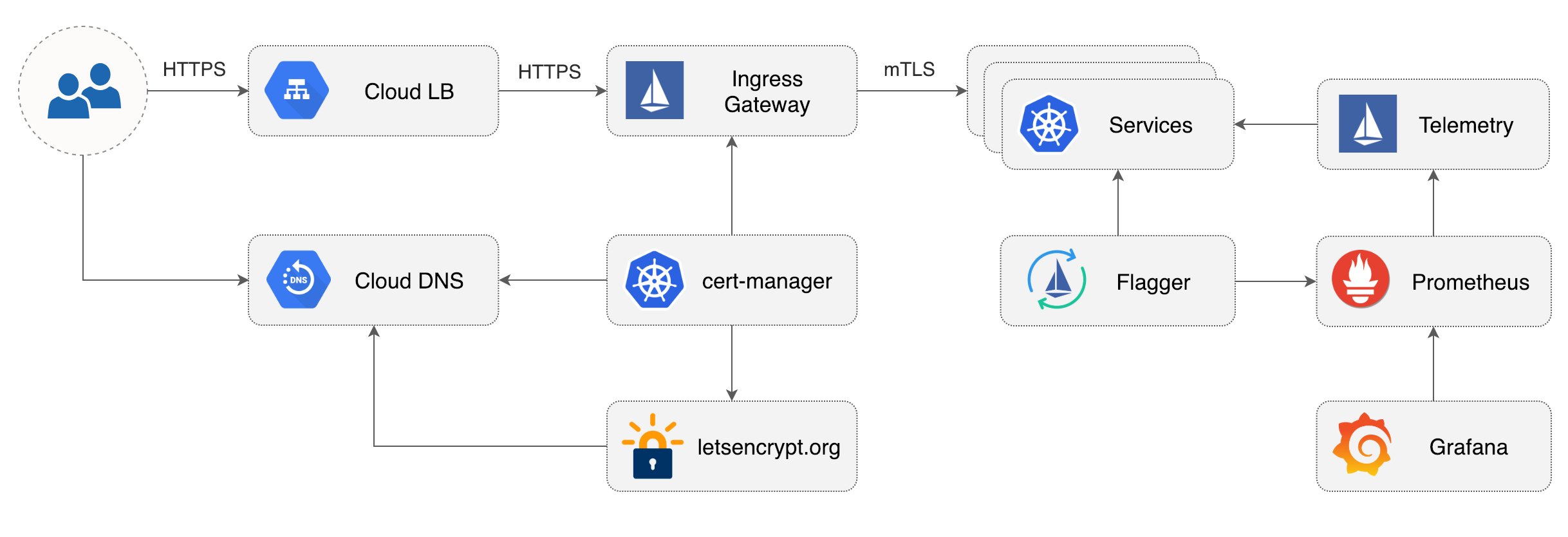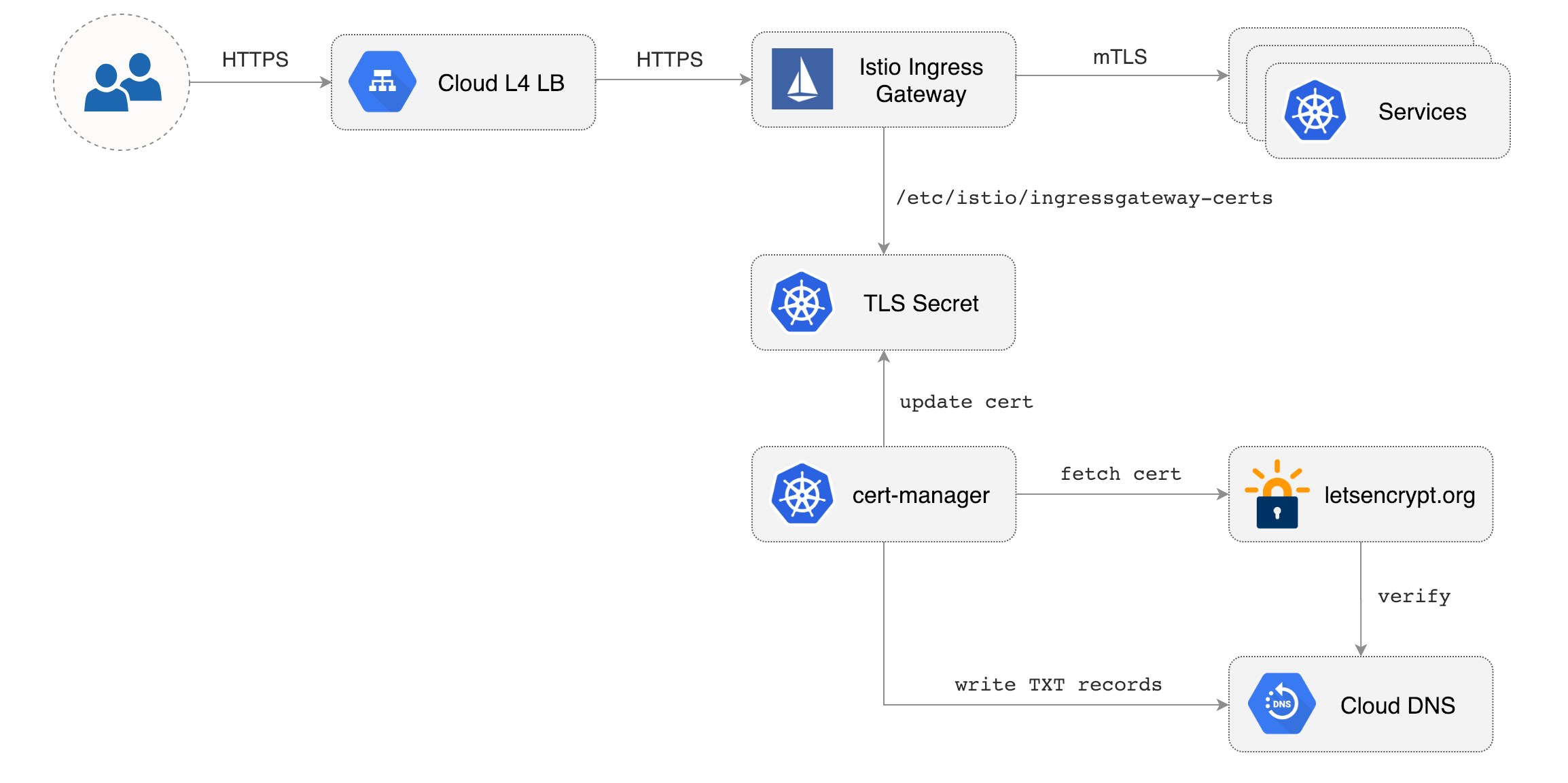Flagger Install on GKE Istio
This guide walks you through setting up Flagger and Istio on Google Kubernetes Engine.

Prerequisites
You will be creating a cluster on Google’s Kubernetes Engine (GKE), if you don’t have an account you can sign up here for free credits.
Login into Google Cloud, create a project and enable billing for it.
Install the
gcloud command line utility and configure your project with gcloud init.
Set the default project (replace PROJECT_ID with your own project):
gcloud config set project PROJECT_ID
Set the default compute region and zone:
gcloud config set compute/region us-central1
gcloud config set compute/zone us-central1-a
Enable the Kubernetes and Cloud DNS services for your project:
gcloud services enable container.googleapis.com
gcloud services enable dns.googleapis.com
Install the kubectl command-line tool:
gcloud components install kubectl
GKE cluster setup
Create a cluster with the Istio add-on:
K8S_VERSION=$(gcloud container get-server-config --format=json \
| jq -r '.validMasterVersions[0]')
gcloud beta container clusters create istio \
--cluster-version=${K8S_VERSION} \
--zone=us-central1-a \
--num-nodes=2 \
--machine-type=n1-highcpu-4 \
--preemptible \
--no-enable-cloud-logging \
--no-enable-cloud-monitoring \
--disk-size=30 \
--enable-autorepair \
--addons=HorizontalPodAutoscaling,Istio \
--istio-config=auth=MTLS_PERMISSIVE
The above command will create a default node pool consisting of two n1-highcpu-4 (vCPU: 4, RAM 3.60GB, DISK: 30GB) preemptible VMs. Preemptible VMs are up to 80% cheaper than regular instances and are terminated and replaced after a maximum of 24 hours.
Set up credentials for kubectl:
gcloud container clusters get-credentials istio
Create a cluster admin role binding:
kubectl create clusterrolebinding "cluster-admin-$(whoami)" \
--clusterrole=cluster-admin \
--user="$(gcloud config get-value core/account)"
Validate your setup with:
kubectl -n istio-system get svc
In a couple of seconds GCP should allocate an external IP to the istio-ingressgateway service.
Cloud DNS setup
You will need an internet domain and access to the registrar to change the name servers to Google Cloud DNS.
Create a managed zone named istio in Cloud DNS (replace example.com with your domain):
gcloud dns managed-zones create \
--dns-name="example.com." \
--description="Istio zone" "istio"
Look up your zone’s name servers:
gcloud dns managed-zones describe istio
Update your registrar’s name server records with the records returned by the above command.
Wait for the name servers to change (replace example.com with your domain):
watch dig +short NS example.com
Create a static IP address named istio-gateway using the Istio ingress IP:
export GATEWAY_IP=$(kubectl -n istio-system get svc/istio-ingressgateway -ojson \
| jq -r .status.loadBalancer.ingress[0].ip)
gcloud compute addresses create istio-gateway --addresses ${GATEWAY_IP} --region us-central1
Create the following DNS records (replace example.com with your domain):
DOMAIN="example.com"
gcloud dns record-sets transaction start --zone=istio
gcloud dns record-sets transaction add --zone=istio \
--name="${DOMAIN}" --ttl=300 --type=A ${GATEWAY_IP}
gcloud dns record-sets transaction add --zone=istio \
--name="www.${DOMAIN}" --ttl=300 --type=A ${GATEWAY_IP}
gcloud dns record-sets transaction add --zone=istio \
--name="*.${DOMAIN}" --ttl=300 --type=A ${GATEWAY_IP}
gcloud dns record-sets transaction execute --zone istio
Verify that the wildcard DNS is working (replace example.com with your domain):
watch host test.example.com
Install Helm
Install the Helm command-line tool:
brew install kubernetes-helm
Create a service account and a cluster role binding for Tiller:
kubectl -n kube-system create sa tiller
kubectl create clusterrolebinding tiller-cluster-rule \
--clusterrole=cluster-admin \
--serviceaccount=kube-system:tiller
Deploy Tiller in the kube-system namespace:
helm init --service-account tiller
You should consider using SSL between Helm and Tiller, for more information on securing your Helm installation see docs.helm.sh.
Install cert-manager
Jetstack’s cert-manager is a Kubernetes operator that automatically creates and manages TLS certs issued by Let’s Encrypt.
You’ll be using cert-manager to provision a wildcard certificate for the Istio ingress gateway.
Install cert-manager’s CRDs:
CERT_REPO=https://raw.githubusercontent.com/jetstack/cert-manager
kubectl apply -f ${CERT_REPO}/release-0.10/deploy/manifests/00-crds.yaml
Create the cert-manager namespace and disable resource validation:
kubectl create namespace cert-manager
kubectl label namespace cert-manager certmanager.k8s.io/disable-validation=true
Install cert-manager with Helm:
helm repo add jetstack https://charts.jetstack.io && \
helm repo update && \
helm upgrade -i cert-manager \
--namespace cert-manager \
--version v0.10.0 \
jetstack/cert-manager
Istio Gateway TLS setup

Create a generic Istio Gateway to expose services outside the mesh on HTTPS:
REPO=https://raw.githubusercontent.com/fluxcd/flagger/main
kubectl apply -f ${REPO}/artifacts/gke/istio-gateway.yaml
Create a service account with Cloud DNS admin role (replace my-gcp-project with your project ID):
GCP_PROJECT=my-gcp-project
gcloud iam service-accounts create dns-admin \
--display-name=dns-admin \
--project=${GCP_PROJECT}
gcloud iam service-accounts keys create ./gcp-dns-admin.json \
--iam-account=dns-admin@${GCP_PROJECT}.iam.gserviceaccount.com \
--project=${GCP_PROJECT}
gcloud projects add-iam-policy-binding ${GCP_PROJECT} \
--member=serviceAccount:dns-admin@${GCP_PROJECT}.iam.gserviceaccount.com \
--role=roles/dns.admin
Create a Kubernetes secret with the GCP Cloud DNS admin key:
kubectl create secret generic cert-manager-credentials \
--from-file=./gcp-dns-admin.json \
--namespace=istio-system
Create a letsencrypt issuer for CloudDNS (replace email@example.com with a valid email address and my-gcp-projectwith your project ID):
apiVersion: certmanager.k8s.io/v1alpha1
kind: Issuer
metadata:
name: letsencrypt-prod
namespace: istio-system
spec:
acme:
server: https://acme-v02.api.letsencrypt.org/directory
email: email@example.com
privateKeySecretRef:
name: letsencrypt-prod
dns01:
providers:
- name: cloud-dns
clouddns:
serviceAccountSecretRef:
name: cert-manager-credentials
key: gcp-dns-admin.json
project: my-gcp-project
Save the above resource as letsencrypt-issuer.yaml and then apply it:
kubectl apply -f ./letsencrypt-issuer.yaml
Create a wildcard certificate (replace example.com with your domain):
apiVersion: certmanager.k8s.io/v1alpha1
kind: Certificate
metadata:
name: istio-gateway
namespace: istio-system
spec:
secretName: istio-ingressgateway-certs
issuerRef:
name: letsencrypt-prod
commonName: "*.example.com"
acme:
config:
- dns01:
provider: cloud-dns
domains:
- "*.example.com"
- "example.com"
Save the above resource as istio-gateway-cert.yaml and then apply it:
kubectl apply -f ./istio-gateway-cert.yaml
In a couple of seconds cert-manager should fetch a wildcard certificate from letsencrypt.org:
kubectl -n istio-system describe certificate istio-gateway
Events:
Type Reason Age From Message
---- ------ ---- ---- -------
Normal CertIssued 1m52s cert-manager Certificate issued successfully
Recreate Istio ingress gateway pods:
kubectl -n istio-system get pods -l istio=ingressgateway
Note that Istio gateway doesn’t reload the certificates from the TLS secret on cert-manager renewal. Since the GKE cluster is made out of preemptible VMs the gateway pods will be replaced once every 24h, if your not using preemptible nodes then you need to manually delete the gateway pods every two months before the certificate expires.
Install Prometheus
The GKE Istio add-on does not include a Prometheus instance that scrapes the Istio telemetry service. Because Flagger uses the Istio HTTP metrics to run the canary analysis you have to deploy the following Prometheus configuration that’s similar to the one that comes with the official Istio Helm chart.
Find the GKE Istio version with:
kubectl -n istio-system get deploy istio-pilot -oyaml | grep image:
Install Prometheus in istio-system namespace:
kubectl -n istio-system apply -f \
https://storage.googleapis.com/gke-release/istio/release/1.0.6-gke.3/patches/install-prometheus.yaml
Install Flagger and Grafana
Add Flagger Helm repository:
helm repo add flagger https://flagger.app
Install Flagger’s Canary CRD:
kubectl apply -f https://raw.githubusercontent.com/fluxcd/flagger/main/artifacts/flagger/crd.yaml
Deploy Flagger in the istio-system namespace with Slack notifications enabled:
helm upgrade -i flagger flagger/flagger \
--namespace=istio-system \
--set crd.create=false \
--set metricsServer=http://prometheus.istio-system:9090 \
--set slack.url=https://hooks.slack.com/services/YOUR/SLACK/WEBHOOK \
--set slack.channel=general \
--set slack.user=flagger
Deploy Grafana in the istio-system namespace:
helm upgrade -i flagger-grafana flagger/grafana \
--namespace=istio-system \
--set url=http://prometheus.istio-system:9090 \
--set user=admin \
--set password=replace-me
Expose Grafana through the public gateway by creating a virtual service (replace example.com with your domain):
apiVersion: networking.istio.io/v1alpha3
kind: VirtualService
metadata:
name: grafana
namespace: istio-system
spec:
hosts:
- "grafana.example.com"
gateways:
- public-gateway.istio-system.svc.cluster.local
http:
- route:
- destination:
host: flagger-grafana
Save the above resource as grafana-virtual-service.yaml and then apply it:
kubectl apply -f ./grafana-virtual-service.yaml
Navigate to http://grafana.example.com in your browser and you should be redirected to the HTTPS version.